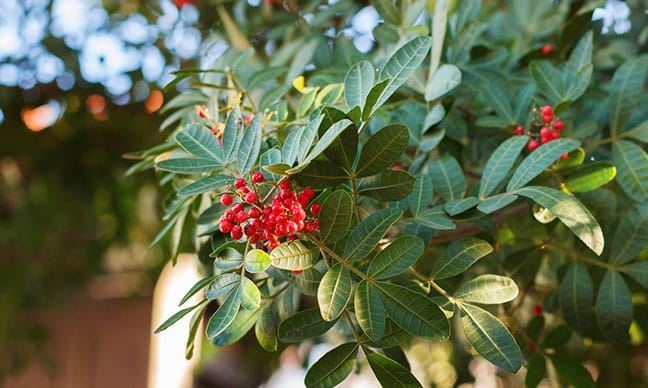The California pepper tree (Schinnus molle) is a sub-tropical small to medium-sized evergreen that grows up to a height of 15 meters and a width of 10 meters. It has drooping branches and a spreading crown, making it one of the best California shade trees. While it is graceful and hardy, it can also be troublesome.
With a plethora of California pepper tree problems and diseases, you need to keep an eye. The tree can be invasive. Not to mention, it can also be a breeding ground of pests that can also affect the healthy trees around it. Read on and learn more about how you can prevent these problems.
The Most Common California Pepper Tree Problems
Before growing this variety of pepper tree, providers of tree services California recommend being familiar with the problems that you might experience.
Root System
The extensive and invasive root system is one of the most common problems to watch out for. While it is a good option for drought-tolerant trees in California, the roots will go anywhere as it looks for water and nutrients. Because of its surface roots, you cannot grow anything under the tree.
With the aggressiveness of the tree’s roots, it is also not advisable that you grow it near pavements, drains, and sewers, among other structures. The expansive roots can damage properties.
Debris
Without a doubt, the California pepper tree is beautiful! It adds aesthetic value to any landscape, especially with its beautiful dropping leaves. Nonetheless, the debris can also be a significant problem, especially come fall. Cleaning your yard can be a headache! You cannot grow plants under the tree because it scatters debris.
On average, the pepper tree grows up to 6-inch blooms. Along with the leaves and berries, the flowers can be a mess. They will drop on the ground, even without wind. While the tree is an evergreen, leaf litter is still a problem.
Toxicity
While the pepper that grows from the tree is edible, it can also be potentially toxic. The University of California lists it as a Class 2 tree, which means that it has minor toxicity. Ingestion isn’t deadly, but it can have unwanted side effects. Its juices and sap can irritate the skin.
Pepper Tree Psyllid
Psyllids are amongst the most common pests that can damage the California pepper tree. The damage is mostly cosmetic. It is most destructive during its nymphal stage. It can cause a deep pit in the foliage. Leaf distortion can also happen, and in high populations, there is a prolific leaf drop.
To manage the infestation of psyllids, using yellow sticky traps is promising. Natural predators, such as ladybugs, will also help in controlling the presence of psyllids. Another good solution is spraying insecticidal soap.
Diseases to Watch Out For
Aside from the problems mentioned above, the tree also experiences a wide array of diseases, including those that are mentioned below.
Armillaria Root Rot
Also known as oak root fungus disease, it is a common disease in broadleaf trees. It starts its havoc at the bottom and works its way to the top. It targets the plant’s cambial tissues, which are necessary for the secondary growth of the tree. The first symptoms of this disease include discoloration of the leaves, which will eventually drop.
The biggest problem with Armillaria root rot is that it can survive on the ground even after decades of tree removal California. To prevent its wrath, work on reducing tree stress and avoid damages to the roots.
Artist’s Conk
Another common type of fungal infection in pepper trees, its symptoms include the formation of semi-circular conks, which can be as thick as eight inches. The bottom of the conk is white, but when scratched, it turns brown. This is where it got its name. By etching the conk, you can leave an artwork.
Implementing the best cultural practices is the best defense against this disease. From pruning broken branches to avoiding mechanical injuries, emphasis should be on maintaining the peak health of the tree to prevent this disease.
Verticillium Wilt
The main target of this fungal disease is the vascular system of the pepper tree. It results in a discoloration of the foliage. Branches and shoots will eventually die. In the worst cases, the entire tree will also die.
Like in many other pepper tree problems and diseases, there is no effective treatment. The best thing that you can do is to execute preventive measures, which include ensuring the health of the tree. Proper tree trimming California is essential to avoid the diseased branches from causing more serious problems.
FAQs
Q: Can you eat the pepper from a California pepper tree?
A: Yes, you can eat the pepper that grows from the pepper tree. It is popular for its many culinary applications. They can be dried and roasted, which you can use as a substitute to pepper. The fruits can also be ground and added to drinks.
Related Post: Best Fruit Trees For Southern California
Q: Are California pepper trees messy?
A: While it is a beautiful and hardy tree, it is also known for being messy, so its upkeep can be a problem for most people. The leaves and dry berries can be unsightly when they gather on the ground.
Q: What does a California pepper tree look like?
A: It has compound and pinnate leaves with fine-textured leaflets. The tree grows yellowish pendant flowers that bloom in clusters, which is followed by globose fruits with woody seeds. With delicate leaflets that grow in weeping forms, it makes a beautiful addition to any landscape.
Q: Do pepper trees grow fast?
A: Yes, pepper trees are known for growing fast. On average, they can grow up to 36 inches in a year, making it a great choice if you are looking for fast-growing trees in California.
Local Tree Experts Overview
A beautiful weeping accent tree, the California pepper tree is known for its astounding beauty. While it is a great addition to any landscape, it can also be a problem. From its invasive roots to different diseases, pay attention to the things mentioned above to keep your pepper tree healthy!




